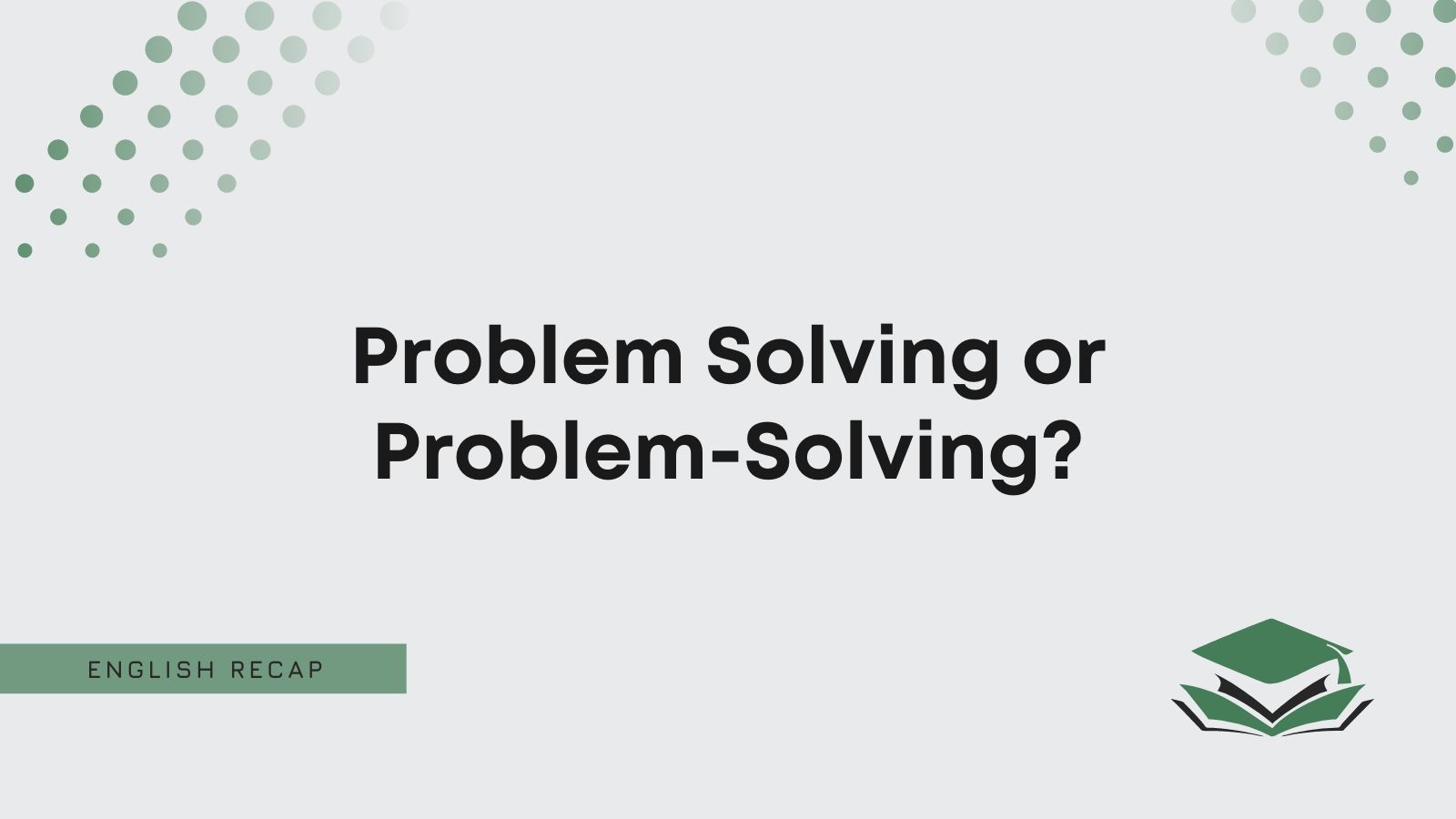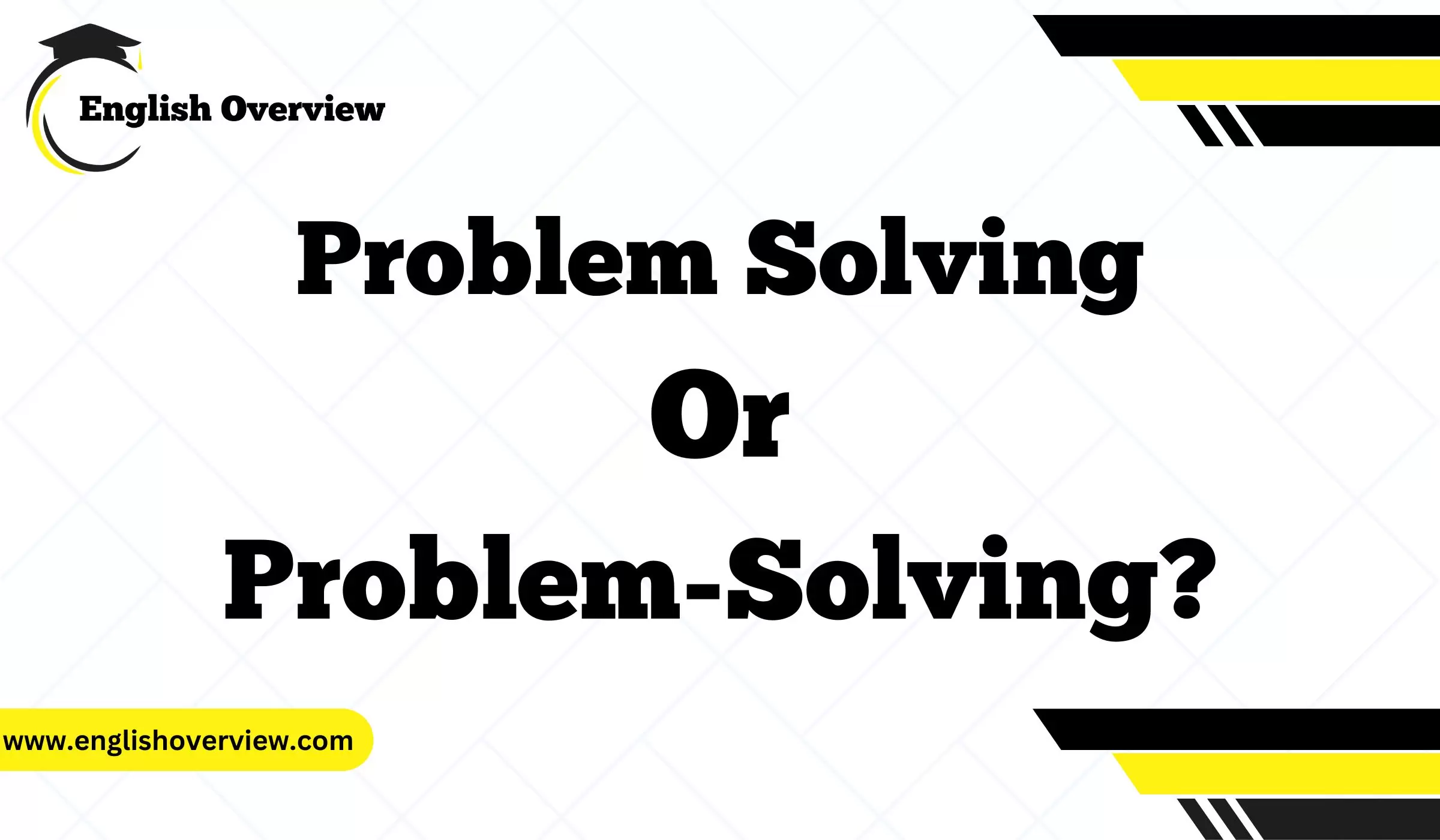

“Problem-Solving” Or “Problem Solving”? Learn If It Is Hyphenated
Is it problem-solving or problem solving? Hyphenation rules seem to be a little confusing when you’re first picking up a language. Don’t worry, though. They’re not nearly as complicated as the language may have led you to believe!
Problem-Solving Or Problem Solving – Hyphenated Or Not?
When we discuss the problem-solving hyphen rule, we learn that problem-solving is hyphenated when used to modify a noun or object in a sentence. We keep the two words separated when using them as their own noun and not modifying anything else in the sentence.
Examples Of When To Use “Problem-Solving”
Now that we’re into the whole debate of problem-solving vs problem solving, let’s look through some examples of how we can use “problem-solving” with a hyphen. As stated above, we use “problem-solving” when modifying a noun or object in a sentence. It’s the most common way to write “problem-solving.” Even the spelling without a hyphen is slowly being pushed out of common language use!
- This is a problem-solving class.
- I hold a problem-solving position at my workplace.
- My manager put me in charge of the problem-solving accounts.
- They say I have a problem-solving mind.
- We’re known as problem-solving children.
Examples Of When To Use “Problem Solving”
Though much less common to be seen written as a phrase noun, it is still worth mentioning. It’s grammatically correct to use “problem solving” at the end of a sentence or clause without a hyphen. However, as we stated above, many people are beginning to prefer the ease of sticking to the hyphenated spelling, meaning that it’s slowly phasing out of existence even in this form.
- I’m good at problem solving.
- This requires a lot of problem solving.
- We are all trained in problem solving.
- My job asks for problem solving.
- Did you say you were good at problem solving?
Is Problem-Solving Hyphenated AP Style?
Have you had a look through the rules in the AP stylebook before? Even if you haven’t, there’s a good explanation for hyphens there. As we stated above, we use hyphens when linking close words that modify a noun or object in a sentence. They’re used to help a reader better understand what is going on through the modification of the clause.
Should I Capitalize “Solving” In The Word “Problem-Solving”?
The question of “is problem-solving hyphenated” was answered, but now we’ve got a new question. What happens to capitalization rules when we add a hyphen to a title. It depends on your own title choices, so let’s look a little further into the three potential options. The first option capitalizes only the first word and any proper nouns in a title. In this case, neither word in “problem-solving” is capitalized.
The second option capitalizes all words except for short conjunctions, short prepositions, and articles. In this case, you will always capitalize “problem” but always leave “solving” uncapitalized. The final option capitalizes every single word in a title. No matter what, you’ll capitalize both words in “problem-solving” when using this style to write your titles.
Does The Rule Also Apply To “Problem Solver” Vs “Problem-Solver”?
The same rule does apply when we use “problem solver” instead of “problem solving.” However, it’s not often that we’ll see a “problem-solver” modifying a noun or object (unless it’s a problem-solver robot or something). So, it’s most likely you’ll write “problem solver.”
Alternatives To “Problem-Solving”
If you’re still struggling with the hyphen rule of whether it’s problem solving or problem-solving, there’s one last thing we can help you with. We can give you some alternatives that have the same meanings but don’t require a hyphen. This way, you can be safe in your own knowledge without having to worry about getting the rules wrong.
- interpretive
Quiz – Problem-Solving Or Problem Solving?
We’ll finish with a quiz to see how much you’ve learned from this article. The answers are all multiple choice, so you should have a blast with them! We’ll include the answers at the end to reference as well.
- I’ve been told that I’m good at (A. problem-solving / B. problem solving).
- I hold my (A. problem-solving / B. problem solving) skills close to my heart.
- We aren’t great at (A. problem-solving / B. problem solving).
- These are all the best (A. problem-solving / B. problem solving) subjects.
- Can we have a go at a (A. problem-solving / B. problem solving) puzzle?
Quiz Answers

Martin holds a Master’s degree in Finance and International Business. He has six years of experience in professional communication with clients, executives, and colleagues. Furthermore, he has teaching experience from Aarhus University. Martin has been featured as an expert in communication and teaching on Forbes and Shopify. Read more about Martin here .
- Full time or Full-time? Learn if “Full time” is hyphenated
- “Well written” or “Well-written”? Learn If “Well written” Is Hyphenated
- “On-Time” Or “On Time”? Learn If “On Time” Is Hyphenated
- Year round or Year-round? (Hyphen Rule Explained)

Problem Solving or Problem-Solving?

The term problem-solving with a hyphen is an adjective that describes nouns in a sentence. E.g., “The problem-solving abilities of this program are excellent.” Furthermore, the term problem solving without a hyphen is a noun. E.g., “He is excellent at problem solving.”
The term problem solving can appear as two different word types, a noun or a compound adjective.
When problem-solving has a hyphen, it is an adjective describing a noun .
For example, in this sentence, problem-solving describes capabilities , which is a noun. Therefore, you need to include a hyphen.
- Her problem-solving capabilities are outstanding.
However, when you use problem solving as a noun , the term is usually not hyphenated because it doesn’t modify anything.
- She is an expert at all types of problem solving .
Furthermore, the rule of using a hyphen for the adjective but not for the noun is correct grammar according to AP Style and the Chicago Manual of Style .
Sometimes in English, the rules concerning punctuation, such as hyphens, are vague. For example, in the Cambridge and Oxford dictionaries, the noun problem-solving appears with a hyphen.
Essentially, you should always use a hyphen for the term problem-solving as an adjective. However, for problem solving as a noun, unless you follow a specific style guide like AP that does not use a hyphen, you can choose whether to hyphenate the noun. Just make sure that you are consistent with your choice.
In addition, Google Ngram shows that problem solving without a hyphen is slightly more popular in the US than with a hyphen. However, in the UK , the hyphenated version is slightly more frequent.
Now that you have learned the basics concerning the term problem solving, please keep reading the rest of the article to learn more about using the two variations of problem solving .
Problem Solving
The term problem solving as two words without a hyphen is the noun form.
In terms of use, it relates to resolving problems, which can relate to problems in a specific discipline or more general problems.
In the following examples, the term problem solving refers to the act of solving problems. Therefore, we do not need a hyphen.
- Her inability to perform problem solving on any task means that she loses her temper quickly.
- You should include problem solving as a skill on your resume.
- In team projects, effective problem solving can lead to innovative solutions and successful outcomes.
- Problem solving is not just about finding immediate answers but understanding the root cause of the issue.
- Her approach to problem solving often involves breaking down complex tasks into manageable steps.
Furthermore, you should use the above rule when following both AP Style or the Chicago Manual of Style.
Problem-Solving
The term problem-solving as one word with a hyphen is a compound word that appears before a noun. Hence, it modifies the noun .
For example, in the following sentence, the word problem-solving modifies the noun skills.
- His problem-solving skills are the best in the company.
- Her problem-solving approach is both methodical and creative, making her a valuable asset to the team.
- The workshop focuses on problem-solving techniques to address everyday challenges.
- Many employers prioritize candidates with strong problem-solving abilities in dynamic work environments.
- The game challenges children to use their problem-solving instincts to navigate various puzzles.
Furthermore, you will come across some sentences in which the noun problem solving has a hyphen.
As shown in these examples:
- You need to work on your problem-solving if you want to become an engineer.
- Improving your problem-solving is essential for success in mathematics.
- Mastering problem-solving will greatly benefit you in software development.
This is often a stylistic choice . However, in writing that follows AP Style , you should not use a hyphen with the noun form of problem solving.
Problemsolving
The word problemsolving as a single word with no hyphen or space is incorrect , and you shouldn’t use it in this format.
There are two ways you can use the term problem solving .
The first is as a noun, in which case there is no hyphen, but there is a space.
- Correct: He is excellent at problem solving because he never gives up. (noun)
- Incorrect: He is excellent at problemsolving because he never gives up. (noun)
- Correct : She has a knack for problem solving , especially in high-pressure situations. (noun)
- Incorrect : She has a knack for problemsolving , especially in high-pressure situations. (noun)
Also, you can write problem-solving as an adjective, in which case you need a hyphen.
- Correct: He is excellent at problem solving because he never gives up. (adjective)
- Incorrect: He is excellent at problemsolving because he never gives up. (adjective)
- Correct : They often turn to her for advice on problem solving in challenging situations. (adjective)
- Incorrect : They often turn to her for advice on problemsolving in challenging situations. (adjective)
That’s all you need to know about the grammar rules concerning the words problem solving , problem-solving , and problemsolving . Rest assured that your sentences will be correct if you follow these!
- Half Day or Half-Day?
- Well Deserved or Well-Deserved?
- Well Written or Well-Written?
- World Class or World-Class?
We are a team of dedicated English teachers.
Our mission is to help you create a professional impression toward colleagues, clients, and executives.
© EnglishRecap
A Comprehensive Guide to Forming Compounds

The Compound
A compound is a word or word group that consists of two or more parts that work together as a unit to express a specific concept. Examples are double-check , cost-effective , around-the-clock , hand-to-hand , forward-thinking , eyeliner , and iced tea . They might also be formed from prefixes or suffixes , as in ex-president , supermicro , presorted , shirtless , or unforgivable .
Basically, compounds are written in one of three ways: solid ( teapot ), hyphenated ( player-manager ), or open (which ranges from phrases such as off and on or little by little to combinations like washing machine —have a field day finding more). Because of the variety in formation, the choice among the styles for a given compound represents one of the most vexing of all style issues writers—and lexicographers—encounter.
For some terms, it is often acceptable to choose freely among open, hyphenated, and solid alternatives, even though the term has been used in English for an extended period (for instance, lifestyle , life–style , or life style ). Although the styling that ultimately takes hold for a compound may be determined by nothing more than editorial and writerly preference, there are patterns of new compounds as they become established in the English language. Compound nouns, for instance, are usually written as one word; compound verbs are generally written as two; compound adjectives are often written with a hyphen. But note that we added "usually," "generally," and "often"—we're hedging. (Be advised that we'll be using noncommittal terms throughout, and, essentially, that's the point of the following articles: there aren't fast rules to forming compounds, but there are patterns.)

The Unit Modifier
Compound adjectives are combinations of words that work together to modify a noun—technically, they work as unit modifiers . As unit modifiers, they are distinguished from other strings of adjectives that may also precede a noun. For instance, in the constructions "a low, level tract of land" or "that long, lonesome highway," the two adjectives each modify the noun separately. We are talking about a tract of land that is both low and level and about a highway that is both long and lonesome. These are regarded as coordinate modifiers .
In the examples "a low monthly fee" and "a wrinkled red shirt," the first adjective modifies the noun plus the second adjective. In other words, we mean that the monthly fee is low and the red shirt is wrinkled. These are noncoordinate modifiers . In the example "low-level radiation," we do not mean radiation that is low and level or level radiation that is low; we mean radiation that is at a low level. Both words are working as a unit to modify the noun—thus, they are unit modifiers .
Unit modifiers are mostly hyphenated. Hyphens not only make it easier for readers to grasp the relationship of the words but also aid in avoiding confusion. For example, the hyphen in "a call for a more-specialized curriculum" removes any ambiguity as to which the word more modifies, and the hyphen in re-sign distinguishes it from resign . Other examples are co-ed and coed , shell-like and shelllike , over-react and overreact , co-worker and coworker , which have either consecutive vowels, doubled consonants, or simply an odd combination of letters and which the inclusion of a hyphen aids in their readability.

The Particle + Noun Compound
Preposition/adverb ( particles ) + noun compounds are styled solid, especially when they are short and the first syllable is accented followed by a syllable with falling stress (as in afterthought , crossbones , download , offhand , upstairs , outfield , onstage , overseas , underhand ). There are also hyphenated particle compounds, like in-house , off-the-cuff , off-line (or offline ), and on-line (or online ).
The styling of Internet ( internet ?)–related compounds ( e-mail / email , website / web site ) remains in flux, with the same compound styled different ways in different publications. We continue to be eagle-eyed lexicographers in our Western Massachusetts-based aerie.

Prefixed, Suffixed, and Combining Form Compounds
Compounds—new, permanent, and temporary—are formed by adding word elements to existing words or by combining word elements. In English, there are three basic word elements: the prefix (such as anti- , non- , pre- , post- , re- , super- ), the suffix (as -er , -ism , -ist , -less , -ful , -ness ), and the combining form ( mini- , macro- , pseudo- , -graphy , -logy ). Prefixes and suffixes are usually attached to existing words; combining forms are usually combined to form new words ( photomicrograph ).
For the most part, compounds formed from a prefix and a word are usually written solid ( superhero ). However, if the prefix ends with a vowel and the word it is attached to begins with a vowel, the compound is usually hyphenated ( de-escalate , co-organizer , pre-engineered ). But there are exceptions: reelection , cooperate , for example. In addition, usage calls for hyphenation between a prefix and a capitalized word or number (post-Colonial, pre-19th century).
A prefixed compound that would be identical with another word, if written solid, is usually hyphenated to prevent misreading ( re-creation , co-op , multi-ply ). Prefixed compounds that might otherwise be solid are often hyphenated in order to clarify their formation, meaning, or pronunciation ( non-news , de-iced , tri-city ). Also, such compounds formed from combining forms like Anglo- , Judeo- , or Sino- are hyphenated when the second element is an independent word and solid when it is a combining form ( Judeo-Christian , Sino-Japanese , Anglophile ).
Some prefixes, and initial combining forms, have related independent adjectives or adverbs that may be used where the prefix might be expected. A temporary compound with quasi(-) or pseudo(-) , therefore, might be written open as modifier + noun or hyphenated as combining form + noun. Thus, the writer must decide which style to follow ( quasi intellectual or quasi-intellectual ; pseudo liberal or pseudo-liberal ).
Compounds formed by adding a suffix to a word are usually written solid ( yellowish , characterless ), except those having a base word that has a suffix beginning with the same letter or is a proper name ( jewel-like , American-ness ). Then, there are unique formations such as president-elect and heir apparent . Additionally, when a word is used as a modifier of a proper name, it is usually attached by a hyphen ("a Los Angeles-based company," "a Pulitzer Prize-winning author").

Permanent and Temporary Compounds
Most two-word permanent and temporary compounds (unit modifiers) are hyphenated when placed before a noun ("one-way street," "a risk-free investment," "East-West trade agreements," "blue-gray/bluish-gray paint") but are often open when following a noun ("The author is well known").
Permanent compounds are those that are so commonly used that they have become—need we say—permanent parts of the language. Temporary compounds are created to meet a writer's need at a particular moment, and they are often formed of an adverb (such as well , more , less , still ) followed by a participle, and hyphenated when placed before a noun ("a still-growing company," "a more-specialized operating system," "a now-vulnerable opponent"). Temporary compounds, often formed from an adverb ending in the suffix -ly followed by a participle, may sometimes be hyphenated but may also be open because adverb + adjective + noun is a normal word order ("an internationally-known artist," "a beautifully illustrated book").
Temporary adjectival compounds may also be formed by using a compound noun. If the compound noun is an open compound , it is usually hyphenated so that the relationship of the words to form an adjective is immediately apparent to the reader ("a tax-law case," "a minor-league pitcher," "problem-solving abilities"). If readily recognizable, the units may occur without a hyphen ("a high school diploma" or "a high-school diploma"; "an income tax refund" or "an income-tax refund"). Also, if the words that make up a compound adjective follow the noun they modify, they fall in normal word order and are, therefore, no longer considered unit modifiers that require hyphenation ("The decisions were made on the spur of the moment"; "They were ill prepared for the journey"; "The comments were made off the record"; "I prefer the paint that is blue gray").

Open or Close the Compound?
When a noun + noun compound is short, and established in the English language and pronounced with equal stress on both nouns, the styling is likely to be open ( bean sprouts , fuel cell , fire drill ). Many short noun + noun compounds, however, that begin as temporary open ones and have the first word accented tend to become solid ( database , football , paycheck , hairbrush ); this is also the case for some adjectives ( shortcut , drywall —but then there's red tape and red-hot ). There are also compounds formed from a verb followed by a noun that is its object, and they tend to be styled as solid ( carryall , pickpocket ). Vice versa, there are noun compounds consisting of a verb form preceded by a noun that is its object ( fish fry , eye-opener , roadblock ), and adjective + noun compounds that are written open ( genetic code , minor league ).
Writers also use a hyphen to make the "unit" relationships of nouns immediately apparent ( English-speakers , Spanish-speaking students , fund-raiser , gene-splicing ), but compounds in which a noun is the object of a following verb-derived word tend to be written open ( problem solver , air conditioning ).
Finally, when the nouns in a noun + noun compound describe a double title or function, the compound is hyphenated ( city-state , secretary-treasurer , hunter-gatherer , bar-restaurant ). And compounds formed from a noun or adjective followed by man , woman , person , or people , as well as denoting an occupation, are regularly solid ( congresswoman , salespeople ). We're pretty sure about those guidelines.

The Verb + Adverb Compound
These compounds may be hyphenated or solid. The compounds with two-letter particles (such as by , to , in , up , on ) are most frequently hyphenated since the hyphen aids in quick comprehension ( lean-to , trade-in , add-on , start-up ). Compounds with three-letter particles ( off , out , through ) are hyphenated or solid with about equal frequency ( spin-off , payoff , time-out , follow-through , giveaway ).
And then there are the verb + -er + particle compounds and verb + -ing + particle compounds. Except for established words like passerby , these compounds are hyphenated ( hanger-on , runner-up , listener-in , falling-out , goings-on , talking-to ). There are also the two-word established forms consisting of a verb followed by an adverb or a preposition, which is styled open: set to , strike out . Then we have words composed of a particle followed by a verb that are usually styled solid ( upgrade , bypass ).

The Compound Noun Turned Verb
The verb form of a compound noun (whether open or hyphenated) most often is spelled with a hyphen ( field-test , water-ski , rubber-stamp ), whereas a verb derived from a solid noun is written solid ( mastermind , brainstorm , sideline ). That one's simple enough. Phew.

To Hyphenate or not to Hyphenate?
That is the question, especially when it comes down to adverb and adjective compounds. And the stickler's answer is to hyphenate when the modifier is before the word it modifies and to write the compound in open form when it follows it (since there is little or no risk of ambiguity). For example, a journalist might publish a word-for-word quotation or a person might be quoted word for word by the journalist, or a writer might be told that what is said is off the record, and any off-the-record information is to remain confidential. However, usage evidence shows that this formula is not closely followed: a team could play back-to-back games or play two games back-to-back; a boss and employee might have a face-to-face discussion or talk face-to-face; a candidate's position might be middle-of-the-road; a child could be accident-prone like his or her accident-prone parent. The point is: many permanent and temporary compounds keep their hyphens after the noun in a sentence if they continue to function as unit modifiers.
But compound adjectives composed of foreign words are not hyphenated when placed before a noun unless they are always hyphenated ("per diem expenses," "the a cappella chorus," but "a ci-devant professor"). Also, chemical names used as modifiers before a noun are not hyphenated ("a citric acid solution"). And a compound noun having three or more words may be either hyphenated or open, depending on preference and usage evidence: editor in chief , base on balls , give-and-take , good-for-nothing , know-it-all , justice of the peace , jack-of-all-trades , pick-me-up , stick-to-itiveness .

The Hyphen as Apostrophe
Hyphens are sometimes used to produce inflected forms of verbs that are made of individually pronounced letters or to add an -er ending to an abbreviation—although apostrophes are more commonly used for the purpose ( x-ed vs. x'd , you decide).
From the time the American League first allowed designated hitters in 1973, another 41 years passed before the first DH was inducted into the Baseball Hall of Fame. Frank Thomas will finally get some company this weekend when Edgar Martinez and Harold Baines join him in Cooperstown, New York. Three Hall of Famers in 46 years is a powerful testament to the challenge of DH-ing. — J. P. Hoornstra, The Orange County Register , 17 July 2019 His continued growth as a player will be key to NU's secondary growing into one of the league's best, and Jackson has the right kind of coach, former NFL-er Travis Fisher, to push him toward it. — Sam McKewon, The Omaha (Nebraska) World-Herald , 2 Aug. 2019

The Hyphen in Chemical Compounds
A hyphen separates prefixes composed of single letters, numerals, or letter-numeral combinations from the rest of a chemical term. In addition, italicized prefixes are followed by a hyphen. The hyphen is also used to separate units of certain chemically complex terms:
α-amino-β-( p -hydroxyphenyl)propionic acid 2-methyl-3-ethylpentane 6 H -1,2,5-thiadiazine
In amino acid sequences, hyphens are used to separate the abbreviations ("Ala-Lys-Pro-Thr-Tyr-Phe-Gly-Arg-Glu-Gly").
It should be noted, however, that most chemical names used as modifiers are not hyphenated ("the amino acid sequence," "sodium hypochlorite bleach").

Hyphenated Numbers
Numbers that form the first part of a compound modifier that express measurement are followed by a hyphen ("a 28-mile trip," "a 10-pound weight," "a nine-pound baby"), or that are used in a ratio ("a fifty-fifty chance," "60-40 chance"). An adjective that is composed of a number followed by a noun in the possessive is not hyphenated ("two weeks' notice," "a four blocks' walk"). Also, when the modifier follows a noun, it is usually not hyphenated ("The teacher required an essay that was five pages"; "Children who are twelve years old and under can order from the menu"; "The fence is 12 feet high").
Hyphens are used in fractions (e.g., two-thirds ), and they join the parts of whole numbers ( twenty-one ). The hyphen is also found in serial numbers, and social security or engine numbers. If you're measuring something, you might also use the hyphen ( foot-pound , kilowatt-hour , column-inch , light-year ), or if you are talking about periods of time ("pre-2000" or "post-2000," or "post-20th/twentieth century").

Reduplicative Compounds
Compounds that are formed by reduplication , and so consist of two similar-sounding elements (such as hush-hush , razzle-dazzle , or hugger-mugger ), are usually hyphenated if each of the elements is made up of more than one syllable, but the solid styling for such words is also common ( crisscross , knickknack , singsong ). For very short words (such as no-no , so-so ), words in which both elements may have primary stress ( tip-top ), and for injections ( tsk-tsk ), the hyphenated styling is more common.

Word of the Day
See Definitions and Examples »
Get Word of the Day daily email!
Games & Quizzes

Usage Notes
Prepositions, ending a sentence with, hypercorrections: are you making these 6 common mistakes, can ‘criteria’ ever be singular, singular nonbinary ‘they’: is it ‘they are’ or ‘they is’, is singular 'they' a better choice, grammar & usage, more words you always have to look up, the difference between 'i.e.' and 'e.g.', more commonly misspelled words, plural and possessive names: a guide, commonly misspelled words, pilfer: how to play and win, 8 words with fascinating histories, great big list of beautiful and useless words, vol. 3, it's a scorcher words for the summer heat, flower etymologies for your spring garden.

Hyphen Rules: Don’t Let Misused Hyphens Muddle Your Adjectives Or Your Writing
Mar 16, 2008 | Grammar and Usage , Proofreading , Punctuation
Rule 1: When compound adjectives come before a noun, the adjectives should be hyphenated.
Compound Adjective: two or more adjectives that work together to describe the same noun
Example 1: On Monday, Mrs. Thomas taught problem-solving skills to her class.
The compound adjective problem-solving tells what kind of skills Mrs. Thomas taught. Since these adjectives come before the noun and work together to describe the noun, it’s necessary to place a hyphen between them.
To understand why the hyphen is needed, remove it, then check the sentence’s meaning—it will be very different:
Example 2: On Monday, Mrs. Thomas taught problem solving skills to her class.
With no hyphen between the two adjectives, the writer’s meaning is unclear. Did Mrs. Thomas teach solving skills that were a problem ? Did she teach two types of skills to her class: problem skills and solving skills? Be sure that your punctuation reflects what you’re trying to say.
Also, watch for words that look like compound adjectives but are really separate, independent adjectives. Take a look at the following sentence:
Example 3: Stephen King is a successful, popular writer.
Here, successful and popular do not form a compound adjective; instead, they are two separate, independent adjectives describing writer , and a comma—rather than a hyphen—should be placed between them. Either word could be used by itself, and the sentence would make sense.
Rule 2: If the compound adjective comes after the noun it describes, no hyphen is needed.
Example 4: On Monday, Mrs. Thomas taught her class many skills, including problem solving .
Since problem solving follows the noun (skills), no hyphen is needed.
Sometimes writers may use what is called a suspending hyphen , a hyphen that is used when two or more adjectives have the same base element, and the base element is shown only with the last term. Consider the following examples:
Example 5: Although they couldn’t wait for their new furniture, Bill and Abby knew that there would be a three- to four-day delay in delivery.
Here, three and four share the base word day . The writer could have written three-day and four-day delay , but using the suspending hyphen creates writing that is more succinct and easier to read.
Example 6: Peter’s knowledge of the case was through second- and thirdhand information.
In this sentence, the hyphen after second tells the reader that second shares the same base element as thirdhand , which is, of course, hand . Again, using the suspending hyphen is more efficient than writing secondhand and thirdhand information .
So far, so good, right? Well, there is an exception to these basic hyphenation rules.
Rule 3: Do not hyphenate when the first of the two words ends in -ly.
Example 7: Maddie is an extremely overworked mother.
Extremely is an adverb. By definition, adverbs describe verbs, adjectives, and other adverbs. In this sentence, extremely is not describing mother (which is a noun) but is telling how overworked Maddie is. Therefore, no hyphen is needed between extremely and overworked .
Rule 4: Watch for special hyphenated nouns.
Example 8: She was the runner-up in the beauty contest.
Other examples can include mother-in-law (and the other in-laws), best-seller, follow-up, etc. When in doubt about a hyphenated noun (as opposed to a compound word, such as letterhead or freeway), don’t guess. It’s always best to look it up in Merriam-Webster’s Dictionary (our dictionary of choice).
Hyphens may be disappearing in some cases (thanks to the Internet), but if you proofread your work carefully and follow these basic rules, they won’t trip you up! Learn more about Writer’s Relief expert proofreaders ! And once your work is proofread, why not use Writer’s Relief’s expertise? We can help target the best markets and boost your odds of getting an acceptance or securing agent representation. Learn more about our services and submit your writing sample to our Review Board today!

Problem Solving or Problem-Solving?
The term “Problem-Solving” or “Problem Solving” often takes center stage in discussions about overcoming challenges. However, the nuances in its usage can be perplexing. This exploration aims to dissect the word, observing its forms as a noun, adjective, and verb. Through five examples for each category, we’ll emphasize correct spelling and punctuation, while delving into the importance of adhering to grammar rules.
The focal point will be the distinction between “Problem Solving” as a verb phrase, “Problem-Solving” as a hyphenated adjective or noun, and the incorrect form “Problem Solving.” Furthermore, we’ll highlight the consistency in usage between UK and US English.
The Noun Form: Problem-Solving
Correct examples.
- Effective problem-solving requires a systematic approach.
- The team showcased remarkable problem-solving skills during the crisis.
- Our workshop focused on collaborative problem-solving techniques.
- She excelled in the art of creative problem-solving .
- The conference highlighted the importance of collective problem-solving efforts.
Incorrect Examples
- Effective problem solving requires a systematic approach.
- The team showcased remarkable problem solving skills during the crisis.
- Our workshop focused on collaborative problem solving techniques.
- She excelled in the art of creative problem solving .
- The conference highlighted the importance of collective problem solving efforts.
Note: The correct noun form is “problem-solving” with a hyphen.
The Adjective Form: Problem-Solving
- The problem-solving approach proved successful in the project.
- Her problem-solving mindset made her an asset to the team.
- A problem-solving mindset is crucial for navigating challenges.
- The group showcased effective problem-solving techniques.
- They developed innovative problem-solving strategies.
- The problem solving approach proved successful in the project.
- Her problem solving mindset made her an asset to the team.
- A problem solving mindset is crucial for navigating challenges.
- The group showcased effective problem solving techniques.
- They developed innovative problem solving strategies.
Note: When used as an adjective, “problem-solving” should be hyphenated.
Read More: In Person or In-Person?
The Verb Form: Problem Solving
- The team collectively worked on problem solving for the project.
- She excels in problem solving by breaking down complex issues.
- They actively engage in collaborative problem solving .
- The committee is dedicated to effective problem solving .
- The approach involves strategic problem solving .
- The team collectively worked on problem-solving for the project.
- She excels in problem-solving by breaking down complex issues.
- They actively engage in collaborative problem-solving .
- The committee is dedicated to effective problem-solving .
- The approach involves strategic problem-solving .
Note: The correct verb form is “problem solving” without a hyphen.
Importance of Grammar Rules
Adhering to grammar rules is paramount for effective communication. Consistency in the use of hyphens, especially in words like “problem-solving,” ensures clarity and maintains the intended meaning. Proper grammar also contributes to professionalism in written and spoken communication.
Consistency in UK and US English
The usage of “problem-solving” remains consistent between UK and US English. Regardless of geographical location, the hyphenated form is universally accepted and preferred.
In conclusion, understanding the nuances of “Problem-Solving” versus “Problem Solving” is vital for clear and effective communication. The correct usage varies depending on whether it functions as a noun, adjective, or verb. Adhering to grammar rules, including the proper placement of hyphens, enhances the precision of language.
The consistency in usage across UK and US English simplifies the application of these rules globally. So, whether discussing strategies, approaches, or mindsets, the choice between hyphenation and separation holds significance in conveying the right message.

Dariel Campbell is currently an English instructor at a university. She has experience in teaching and assessing English tests including TOEFL, IELTS, BULATS, FCE, CAE, and PTEG . With over a decade of teaching expertise, Dariel Campbell utilizes his knowledge to develop English lessons for her audience on English Overview.
Leave a Comment Cancel reply
You must be logged in to post a comment.
Welcome to The English Overview, where we help to improve your language skills. Explore lessons on words, sentences, punctuation, and more. Enhance your English fluency and easily create powerful expressions. Come along on a journey to become excellent in language.
Privacy Policy
Latest Articles

Game Design Principles That Aspiring Developers Should Know
July 18, 2024

What Types of Student Accommodations Are Available in London?

A Candid Review of Uk-iptv.uk: Streaming Redefined or a Mere Distraction?
July 17, 2024
© 2024 English Overview

English Intelligent
Is Problem-Solving Hyphenated?
Hyphens are a complicated grammar point that is difficult to learn. One word that many people get confused about is “problem-solving.” You will see this word used often in formal environments, especially with a hyphen. Is problem-solving hyphenated?
Yes, problem-solving is hyphenated because it is an adjective modifying a noun. Problem-solving is what is called a compound adjective, meaning it needs the hyphen. Without the hyphen, problem-solving becomes problem solving and takes on a completely different meaning that you should not use when describing a noun.
The rest of this article will cover what problem-solving means and how to use problem-solving in a sentence.
What Does Problem-Solving Mean?
Problem-solving is a compound adjective that describes the process of fixing a problem. If you break it down, you’ll see the compound has two words: problem and solving. Problem is a harmful situation that needs to be dealt with. Solving is the resolution to situations like problems.
When you put the two words together, you get “problem-solving”, or the methods people take to solve a problem. For example, if someone says “You have great problem-solving skills,” they mean you can solve problems well.
Since school revolves around solving problems, you will see the word “problem-solving” everywhere in school environments. The same applies to work. A lot of businesses require employees to think on their feet and adapt to different problems.
If you want to impress your bosses or professors, make sure you add a hyphen in between problem and solving so the word is spelled correctly. Without the hyphen, problem-solving is no longer the same word.
Multi-word expressions need to have hyphens between them if they are being used to describe a noun. When being used to describe a noun, you should always add a hyphen to “problem-solving.”
How To Use Problem-Solving In A Sentence
Problem-solving is an adjective, meaning you need to use it to describe a person, place, or thing. It can be both positive and negative depending on the context of the sentence. For example, if you say someone has bad problem-solving skills, that is a negative use of the word.
Here are a few examples of “problem-solving” used in a sentence:
- “Last week, John went to Amy and helped her work on her problem-solving skills.”
- “After watching Jessica quickly adapt to her new workload, I have concluded that she has amazing problem-solving skills.”
- “Problem-solving skills are important because they help you think on your feet, adapt to a wide variety of situations, and help others more effectively.”
Leave a Reply Cancel reply
Your email address will not be published. Required fields are marked *
Save my name, email, and website in this browser for the next time I comment.
This site uses Akismet to reduce spam. Learn how your comment data is processed .
Stack Exchange Network
Stack Exchange network consists of 183 Q&A communities including Stack Overflow , the largest, most trusted online community for developers to learn, share their knowledge, and build their careers.
Q&A for work
Connect and share knowledge within a single location that is structured and easy to search.
What are the Differences in Meaning Between "Problem Solving" and "Solving Problems"
Problem Solving tells us what you do.
Solving Problems tells us what you do it to.
Is there any other difference in meaning in the context of math word problems?
- "He loves nothing better than problem solving; or, "He loves nothing better than solving problems." Each sentence says pretty much the same thing. – rhetorician Commented Dec 25, 2014 at 2:45
2 Answers 2
In principle a connection of gerund and object can have three forms
1 the solving of problems (in Latin Grammar "problems" is called genetivus objectivus, i.e. "problems" corresponds to an object in a normal sentence with a finite verb.)
2 solving problems
3 problem solving/problem-solving
In 1 we have the full form with the and of. 2 is derived from 1 by dropping the and of. 3 is derived from 2 by putting "problems" in front position.
All three forms have the same meaning. Which form will be used is a matter of style. Form 2 is the common form.
Even "I'm solving problems" might be derived from form 1: I'm at/in the act of (the) solving (of) problems.
Well, "problem solving" is a noun (or, when hyphenated, an adjective); but "solving problems" is a present-progressive tense verb with an object.
Thus, "He has good problem-solving skills." But: "I am solving problems", rather than "I am problem solving".
But these are only matters of syntax. In answer to your question, no, there is no difference in meaning.
Your Answer
Sign up or log in, post as a guest.
Required, but never shown
By clicking “Post Your Answer”, you agree to our terms of service and acknowledge you have read our privacy policy .
Not the answer you're looking for? Browse other questions tagged meaning or ask your own question .
- Featured on Meta
- Announcing a change to the data-dump process
- Upcoming initiatives on Stack Overflow and across the Stack Exchange network...
- We spent a sprint addressing your requests — here’s how it went
Hot Network Questions
- Flights canceled by travel agency (kiwi) without my approval
- Preparing a murder mystery for player consumption
- What's to prevent us from concluding that Revelation 13:3 has been fulfilled through Trump?
- Designing an attitude indicator - Having issues with inclinometer
- How can I handle an ambitious colleague, promoted ahead of me, that is self-serving and not that great at his job?
- Did Arab Christians use the word "Allah" before Islam?
- How to move the color blocks into the red frame region marked?
- What is the meaning of the "Super 8 - Interactive Teaser" under "EXTRAS" in Portal 2?
- Is it rude to ask Phd student to give daily report?
- Poincaré duality and Mayer–Vietoris sequence
- How much coolant drip is normal on old car without overflow tank
- What is the function of this resistor and capacitor at the input of optoisolator?
- Detailed exposition of construction of Steenrod squares from Haynes Miller's book
- Wait, ASCII was 128 characters all along?
- Why is this image from pianochord.org for A11 labeled as an inversion, when its lowest pitch note is an A?
- Find the segment "DC" in the obtuse triangle below
- Is "farfel" an idiolectical quirk/part of a familect?
- Narcissist boss won't allow me to move on/sabotaged internal transfer
- Why is the MOSFET in this fan control circuit overheating?
- What is a good translation for these verbal adjectives? (Greek)
- Is there an equivalent of caniuse for commands on posix systems?
- I'm 14 years old. Can I go to America without my parent?
- Can a counterexample to a method of proof be published in a paper?
- When Trump ex-rivals, who previously gave Trump terrible comments, now turn to praising him, what benefits could they gain?
Daily Writing Tips
Hyphenation in compound nouns.

I was reading the jacket copy for Garner’s Modern American Usage , the successor to the similarly titled classic reference work by H.W. Fowler, when I found what I felt to be an ironic instance: an error. The book’s description refers to its attention to “questions . . . of word-choice.”
Whenever I see hyphenated compound nouns such as this, I feel as if I’m being whisked in a time machine to a bygone era in which hyphenation of word pairs was rampant: to-day , co-operate , tea-cup , and so on. Why on earth, I thought, did the copywriter think that word-choice merits hyphenation?
Continuing to read the copy, I stumbled once again, while reading a reference to “language-lovers of all persuasions.” By this time, I thought it unfortunate that a book that purports (with eminent justification) to be a trusted authority on proper usage should have two superfluous hyphens in the jacket copy.
Authors are usually given the opportunity to proof their books, and occasionally have a chance to weigh in on the cover art, but rarely, if ever, do they get to see jacket copy before publication. I wondered whether Garner had noticed these errors when he received his first copy.
Minutes later, I was reading an entry, and I noticed the second error repeated therein: “The word denotes a well-informed language-lover and word connoisseur.” This time — assuming the author, while reading the proof, had not overlooked a copy editor’s erroneous insertion — the culprit was Garner himself. Only then did I realize I had fallen into a trap that the English language often lays for the erudite and the inexperienced alike: the expectation that it will be consistent.
The hyphenation of word-choice is unequivocally wrong, but who is to say that Garner and the jacket-copy writer erred with language-lover ? Many writers insert a hyphen in “decision making,” “problem solving,” and the like, though such treatment is justified only when the compound modifies a following noun (“decision-making apparatus,” “problem-solving skills”). However, similar noun+verb compounds, like eye-opener , are valid.
The final arbiter of how a word is treated is a dictionary — or, if a publication for some reason prefers an alternate form, a published style guide such as The Chicago Manual of Style or a house, or internal, style guide compiled by one or more editors of that publication. In the case of language-lover , the term does not appear in Merriam-Webster’s Collegiate Dictionary , nor does it grace Chicago’s pages.
I don’t know whether the house style guide of the Oxford University Press, which published Garner’s book, covers this point, but now I know why, in that work, a hyphen appears in language-lover : It was published in the United Kingdom, whose form of English (the oldest among nations where English is widely spoken, though that doesn’t make it the definitive form) has only recently begun to veer from favoring such constructions.
An online search for “language lover” yields one hyphen-free usage after another, which confirms my opinion that in American English, at least, the hyphen is extraneous. And a writer’s rule of thumb is that if a term has not made its way into a dictionary, use a corollary form (would you hyphenate “cat lover” or “coffee lover”?) or, in the absence of a similar term, use the simplest possible construction.

Stop making those embarrassing mistakes! Subscribe to Daily Writing Tips today!
You will improve your English in only 5 minutes per day, guaranteed!
Each newsletter contains a writing tip, word of the day, and exercise!
You'll also get three bonus ebooks completely free!

10 thoughts on “Hyphenation in Compound Nouns”
No-one (that’s no-one not noone) writes cooperate in the UK. It’s always written as co-operate. But I am curious to know why you wrote jacket-copy writer. And not jacket copy writer or jacket copywriter?
I speak and write American English, and my posts almost invariably represent that bias, hence my reference to the obsolescence of co-operate. (And we don’t hyphenate no-one.)
I hyphenated “jacket copy” because that phrase modifies writer. “Jacket copywriter” implies someone who crafts prose to be printed on coats. If I wished to use copywriter, I would say “book-jacket copywriter,” which would also be correct in this context.
I find this discussion very interesting but do not entirely agree. (Bear in mind that I am British.)
I agree on “word choice” (there should be no hyphen) but disagree on “language-lover” (hyphen required in my opinion).
Being a translation quality manager by profession, but with no formal training in linguistics, semantics or other relevant specialised fields, I have developed my own rules on the basis of wide reading experience, study of established (British) reference works and the application of logic.
Applying this approach, I developed the following arguments on this subject:
Where the main nouns in word pairs can stand alone, either generally or in a context that helps to define them, there is no need for a hyphen. (Examples: roof insulation, steam engine, heart attack and oil well). Thus, if we hear “I’m going to the well today”, as long as we know that the speaker is an oil worker (and not a drawer of water), it is perfectly understood that well means oil well and the terms are interchangeable.
Hence my agreement on “word choice”.
However, a fireman’s wife would never describe her husband as a “fighter”, we would not point to the birds gathering on the “table” and we would not leave our car in the “park”. And if we were discussing a watch’s suitability for use while swimming, we would not talk of its “resistance”, even though the context made it clear that resistance to dust or shocks was not being referred to. So in the terms “fire-fighter”, “bird-table”, “car-park”, and “water-resistance” the two nouns are indissociable and therefore require a hyphen.
This is why I feel that “language-lover” does require a hyphen.
Incidentally, I heartily agree with Sarah Turner on “no-one” (in preference to the often-used “no one”, which to my mind has a different meaning (e.g “Of the many ideas put forward, no one solution on its own was seen as workable”), and I also favour “co-operate”, though I note that “cooperate” is considered correct in the US and find that it increasingly being used in the UK too (along with coordinate, proofread, etc., etc.) I read somewhere recently that the OED had just published a very long list of words that were previously hyphenated in British English for which the hyphen could (should?) be dropped.
It was published in the United Kingdom, whose form of English (the oldest among nations where English is widely spoken, though that doesn’t make it the definitive form) has only recently begun to veer from favoring such constructions.
Not so. American English is very often an older form, long obsolete in British English, which long along “veered from favouring such constructions.” (And sometimes veers back again, under American influence). See the use of “gotten”, for example.
No-one (that’s no-one not noone) writes cooperate in the UK.
I beg to differ: “no one” and “cooperate” are the primary spellings listed in the OED. I’m not sure I’ve ever seen “co-operate”, except hyphenated across a line-break…
What is the correct way of writing one-year-old-child (or two, three, four etc.)? Should it be hyphenated or left as single words, or just the three words (numeral)-year-old hyphenated with child being the noun?
The latter, because “one-year-old” modifies child.
In response to Peter:
I was taught at school (in UK) that hyphens were required where the attachment of prefixes without could modify pronunciation due to vowel combination.
Hence, co-operate, co-ordinate, no-one, pre-empt, etc.
However, this was in the 1970s. And I left the UK in 1990. So I appreciate being brought up to date by columns such as this one and probably will start to adopt “cooperate” and coordinate”, though I still resist “no one” (= nobody) for the reason I give above.
On the question of American English having retained old usage long-since discarded this side of the Atlantic, Bill Bryson’s book “Mother tongue” gives some interesting examples.
I don’t think language-lover should be hyphenated in general, but in the phrase “well-informed language-lover” I think it is very acceptable to hyphenate in order for “well-informed” to modify “a lover of languages” and not just “language”. Not that anyone would interpret it that way, but without the hyphen, the emphasis of how you read it to yourself would make it seem that the language was well-informed, not the lover of the language (an absurdity, of course).
I have to say hyphenation of compound words in English is completely arbitrary. Sometimes you separate them out into two words, sometimes you put them together, sometimes you separate with a hyphen. All completely just based on the standard of the moment, and language is constantly in flux.
This was a great post—very helpful.
There’s just one error: In the third-last paragraph, you used the word “alternate” when you meant “alternative.”
To add some thought–I have understood punctuation as a tool used to in writing to denote how the words are heard not solely what they mean on paper. A writer can apply punctuation to words and modify a message. Therefore a hyphen would add to the understanding that the words on either side of the hyphen are to be spoken as one. Such as you mentioned “eye-opener” is a well accepted expression identifying a subject. I think the difference in thinking stems from thinking that hyphenated words are words themselves VS. the idea that punctuation is applied to words to create new meaning. I think using the latter.
Leave a Comment
Is Problem-Solving Hyphenated? Rules & Examples

The Cambridge Dictionary defines "problem solving" as the ability to find solutions to different problems.
Problem-solving with a hyphen is among the most used hyphenated compound nouns; however, according to various English language grammar rules, its use depends on the context.
So, is problem-solving always hyphenated? What are the most basic rules we should know before using this phrase's noun form? Let's find out.
Should I Write Problem-solving or Problem Solving?
Both “problem-solving” and “problem solving” are correct, but they are not typically used interchangeably, in line with basic noun hyphenation rules.
If you are using the term as an adjective to describe a noun, you should write "problem-solving" with a hyphen. For example: "The problem-solving skills of the team are remarkable."
If you are using the term as a noun , you should write "problem solving" without a hyphen. For example: "She excels in problem solving."
The decision to use a hyphen or not depends on whether you are using the term as a compound adjective or a standalone noun.
Differences Between Problem-Solving and Problem Solving
Both “problem solving” and “problem-solving” are common language phrases with the same meaning, but their form varies depending on context. There are three punctual differences between these two terms:
1. Grammar and Usage:
- "Problem-solving" (with a hyphen) is used as a compound adjective to describe a noun. For example, "The problem-solving skills of the team were evident."
- "Problem solving" (without a hyphen) is used as a noun. For example, "She excels in problem solving."
2. Hyphen Usage:
- The hyphen in “problem-solving” indicates its function as a compound adjective. It follows the grammatical convention of using hyphens in compound adjectives.
- “Problem solving” without a hyphen is a standard noun form; here, a hyphen isn't used because it doesn't function as a compound adjective modifying another noun.
3. Clarity and Emphasis:
- "Problem-solving" can be used when you want to emphasize the adjective nature of the term, highlighting the skills or abilities related to solving problems.
- "Problem solving" as a noun may be preferred when you want to emphasize the action or concept itself, without focusing on its role as an adjective modifying another noun.
Problem-Solving Sentence Examples
Here are some sentence examples using “problem-solving” as a compound adjective:
- The problem-solving team quickly addressed the technical issues.
- We need a problem-solving approach to tackle the current challenges.
- His problem-solving skills proved invaluable in resolving the customer complaints.
- The problem-solving workshop provided practical strategies for decision-making.
- The project's success was attributed to effective problem-solving strategies.
- Team members showcased their problem-solving abilities during the simulation.
- The software engineer's problem-solving mindset improved system efficiency.
- The company values employees with strong problem-solving capabilities.
- A problem-solving mindset is crucial in adapting to changes in the SEO landscape.
Problem Solving Sentence Examples
Here are some examples of using 'problem solving' as a noun phrase:
- Effective problem solving requires creativity and critical thinking.
- Her problem solving led to a successful resolution of the conflict.
- The company encourages a culture of continuous improvement through problem solving.
- Problem solving is a key competency in leadership roles.
- Within collaborative projects, effective problem solving can lead to innovative solutions and successful outcomes.
How to Use Problem-Solving or Problem Solving
If you find yourself uncertain about whether to use "problem-solving" or "problem solving" these three main rules can provide clarity and help you make the right choice:
1. Adjective vs. Noun:
- Use “Problem-Solving” (with a hyphen): When using the term as a compound adjective to describe a noun.
- Use "Problem Solving" (without a hyphen): When you are using the term as a standalone noun.
2. Emphasis on Skill or Process:
- Use "Problem-Solving" (with a hyphen): When you want to emphasize the skills, abilities, or characteristics related to solving problems. For example, "The SEO team demonstrated excellent problem-solving capabilities.
- "Use "Problem Solving" (without a hyphen): When you want to focus on the general concept or activity of solving problems without emphasizing specific skills. For example, "Effective problem solving is crucial in digital marketing."
3. Adherence to Style Guides:
- Use "Problem-Solving" (with a hyphen): If you are following style guides such as AP Style or the Chicago Manual of Style, which recommend using a hyphen when the term is used as a compound adjective.
- Use "Problem Solving" (without a hyphen): If you are following a more casual or flexible writing style, or if you prefer a simpler, non-hyphenated form.
Summary: Is Problem-Solving Hyphenated?
There you have it - "problem-solving" with a hyphen serves as a compound adjective, highlighting specific skills related to addressing challenges, while "problem solving" without a hyphen is a standalone noun emphasizing the broader concept of resolving issues.
Vary the use of this phrase based on the sentence context and the intended meaning, as it solely depends on the term's grammatical role.
Write better perfectly
Get the Reddit app
A place for learning English. 英語の学びのスペースです。 Un lugar para aprender Inglés. مكان لتعلم اللغة الإنجليزية. Un lieu pour apprendre l'Anglais. Ein Ort zum Englisch lernen.
Should “problem solving” be hyphenated?
Please refer to the sentence below.
“Demonstrated problem solving by rectifying technical issues”
Should it be hyphenated?
- Dictionaries home
- American English
- Collocations
- German-English
- Grammar home
- Practical English Usage
- Learn & Practise Grammar (Beta)
- Word Lists home
- My Word Lists
- Recent additions
- Resources home
- Text Checker
Definition of problem-solving noun from the Oxford Advanced Learner's Dictionary
problem-solving
- to develop problem-solving skills and strategies
Join our community to access the latest language learning and assessment tips from Oxford University Press!
Nearby words
Hyphens and Dashes
Hyphens (-).
Hyphens are only used to combine certain words together. They are not strong enough to set off phrases or words from a sentence. Use hyphens in the following situations:
- Use in compound numbers and fractions.
Examples: twenty-nine, two-thirds
- Join multi-word nouns read as a single unit.
Examples: sister-in-law, nine-year-old, mid-July
- Combine two adjectives that are working together to describe the same noun.
Example: Maria is a self-conscious writer.
Maria is not a self writer or a conscious writer: both words must work together to describe her, so they are hyphenated.
- 26-year-old woman but woman who is 26 years old
- 10-page paper but a paper that is 10 pages long
- new-consultant training but training for new consultants
- over-the-counter medicine but medicine that is over the counter
- Don't use between an adverb and adjective.
Example: They shared a very tender and extremely memorable moment.
- Always use between an adverb and a participle (verb form that describes a noun). Consider the following examples:
Examples: well-developed, well-known, self-correcting, home-cooked, problem-solving, ill-advised, fast-moving, friendly-sounding
- Use a "suspended" hyphen when at least two similar compound words appear next to each other and the final portion of the compound has been eliminated to avoid repetition. The hyphen appears after the first compound, regardless if the compound normally has a hyphen. A hyphen occurs in the main compound only if it would normally be hyphenated.
Example: Are her father- and mother-in-law coming over for dinner?
Example: Is it a nine- or ten-story building?
Example: He under- or overestimated all of his opponents.
Example: Mrs. Harris has taught first-, second-, and third-grade at my elementary school.
Proofreading Tip
If you're unsure whether a hyphen is needed, check an online dictionary or paste the phrase into Google and check common usage.
Short Dashes
Short dashes ( – ) are more commonly called "en" dashes, because they are the length of the letter "n" and often combine numbers. Short dashes often replace hyphens to prevent confusion and have the following roles:
- January–April (meaning January through April)
- one–five (meaning one through five)
- anti–New York view
- New Jersey–Paris flight
- non–computer literate adult
- pro-life–pro-choice debate
Long Dashes (—)
Long dashes (—) are more commonly called "em" dashes, because they are the length of the letter "m." These longer dashes are created in Microsoft Word by placing two hyphens right after a word and hitting Enter. Word will then autocorrect the two hyphens into a dash. Use long dashes in the following situations:
- Emphasize additional information in the middle or end of a sentence. Long dashes provide more emphasis than a comma or parentheses and can indicate a pause to slow your reader.
Example: Daniel —in all fairness— had no choice but to become Mrs. Doubtfire.
Example: She was an ESL (English as a second language) student —someone who is still learning how to speak/write in English .
- Replace commas to prevent confusion when restating or describing a noun.
Example: The Spice Girls —Sporty, Baby, Posh, Scary, and Ginger— were the biggest cultural icons of the 1990s.
Example: When I woke up, I had a lot of cold symptoms —coughing, sneezing, and a headache .
- Indicate an abrupt change in thought or shift in tone.
Example: Jurassic World was amazing with today’s graphics —but I’m getting ahead of myself .
- Replace a semicolon to combine two complete sentences.
Example: The Eiffel Tower is the most visited paid monument in the world—it features restaurants on both the first- and second levels.
Long dashes can either have spaces on both sides or no spaces on either side.
Example, with spaces: Dinner tonight is going to be so delicious — roast beef, green beans, and potatoes!
Example, without spaces: Dinner tonight is going to be so delicious—roast beef, green beans, and potatoes!
501 E. High Street Oxford, OH 45056
- Online: Miami Online
- Main Operator 513-529-1809
- Office of Admission 513-529-2531
- Vine Hotline 513-529-6400
- Emergency Info https://miamioh.edu/emergency
1601 University Blvd. Hamilton, OH 45011
- Online: E-Campus
- Main Operator 513-785-3000
- Office of Admission 513-785-3111
- Campus Status Line 513-785-3077
- Emergency Info https://miamioh.edu/regionals/emergency
4200 N. University Blvd. Middletown, OH 45042
- Main Operator 513-727-3200
- Office of Admission 513-727-3216
- Campus Status 513-727-3477
7847 VOA Park Dr. (Corner of VOA Park Dr. and Cox Rd.) West Chester, OH 45069
- Main Operator 513-895-8862
- From Middletown 513-217-8862
Chateau de Differdange 1, Impasse du Chateau, L-4524 Differdange Grand Duchy of Luxembourg
- Main Operator 011-352-582222-1
- Email [email protected]
- Website https://miamioh.edu/luxembourg
217-222 MacMillan Hall 501 E. Spring St. Oxford, OH 45056, USA
- Main Operator 513-529-8600
Initiatives
- Miami THRIVE Strategic Plan
- Miami Rise Strategic Plan
- Boldly Creative
- Annual Report
- Moon Shot for Equity
- Miami and Ohio
- Majors, Minors, and Programs
- Inclusive Excellence
- Employment Opportunities
- University Safety and Security
- Parking, Directions, and Maps
- Equal Opportunity
- Consumer Information
- Land Acknowledgement
- Privacy Statement
- Title IX Statement
- Report an Accessibility Issue
- Annual Security and Fire Safety Report
- Report a Problem with this Website
- Policy Library
A Word, Please: Should you use a hyphen? It often depends on the part of speech

- Copy Link URL Copied!
Do you ever login to your email? Or do you log in? Either way, do you use your log-in? During the holiday season, do you use gift wrap to gift-wrap gifts? Do you use your pickup to pick up the kids as they hang out at their favorite hangout?
If you find these matters intimidating, don’t. Even people with excellent language and punctuation skills can be stumped when it’s time to decide whether a term should be one word, two words or hyphenated.
Really, how could you guess that a water-skier water skis on water skis? And even if you did suss out that water-skiing takes a hyphen, your sussing skills would betray you if you had to write about skeet shooting, which is not hyphenated.
If you don’t want to stress over these matters, good news: You don’t have to. No one is expected to know them all. Not even copy editors commit all these terms to memory.
But if you would like to approach these hyphenation situations with greater confidence, you need to know where to look them up and how.
Most of the time, you’ll find answers in the dictionary. But don’t just skim the entry word to see if there’s a hyphen in it. Note what part of speech you’re looking for — noun, verb or adjective — then find that form under the entry word. Otherwise, you could glimpse “water ski” in the dictionary and assume it’s correct to write that you like to water ski.
According to Merriam-Webster’s, the noun meaning a piece of sports equipment takes no hyphen — it’s a water ski. But the verb does — you water-ski. Water-skier has its own entry, complete with hyphen.

A Word, Please: Whet your grammar skills with this list of common terms people get wrong
Webster’s will help clear up misconceptions about what you heard and what you think you heard.
March 5, 2021
Of course, water-skiing probably doesn’t come up as much as logging in to websites and email accounts. But the terms “log in” and “log on” are a little messier. For a simple guide, remember that the verb form is two words. You never login to your account. You log in. Merriam-Webster’s actually doesn’t have an entry for “log in” or “login.” They have one for “log on,” where they note that “log in” is an alternative form.
Interestingly, there is no noun form of “logon” or “login” in Merriam’s. Instead, the dictionary lists the noun as hyphenated. So according to this dictionary you log on using your log-on and you log in using your log-in.
Personally, I think Merriam’s is a little behind the times on this one. It’s common for two-word and hyphenated forms to slowly merge into closed one-word forms, like “teen-ager” and “good-bye.” So I’ll allow “login” or “logon” as a noun when I’m editing.
I will not, however, allow “log into” or “log onto.” To my mind, “log in” and “log on” are phrasal verbs and “log into” and “log onto” are not. Merriam’s has my back on this to a certain degree: The dictionary treats “log in to” and “log on to” as the preferred forms, but it also recognizes “into.”
In most cases, you’ll find that verb forms tend to be open compounds: pick up, gift wrap, hang out. Nouns are often one word: hangout, pickup. But you’ll find a lot of nouns hyphenated in the dictionary, too: problem-solving, decision-maker. Some nouns aren’t listed, like the paper we call gift wrap. In those cases, you can just combine two words, usually without a hyphen: gift wrap.
Adjectives are a little different. For these, if they’re not in the dictionary, there’s a rule you can apply: Hyphenate any two words used to modify a noun anytime the hyphen could aid understanding. A woman eating lobster, after all, is quite different from a woman-eating lobster. But if your compound includes an adverb that ends in “ly,” no need for a hyphen. The adverb form itself eliminates all chance of confusion when you write about a “happily married couple” or a “beautifully composed musical score.”
Just don’t feel bad that you don’t know all the answers. No one does.
June Casagrande is the author of “The Joy of Syntax: A Simple Guide to All the Grammar You Know You Should Know.” She can be reached at [email protected] .
Support our coverage by becoming a digital subscriber.
All the latest on Orange County from Orange County.
Get our free TimesOC newsletter.
You may occasionally receive promotional content from the Daily Pilot.

The Crowd: Balboa Bay Club hosts 2,000 visitors to annual car show
July 19, 2024

Mailbag: Air show and hot air in Huntington Beach
July 18, 2024

A Word, Please: Seven words whose common use would have made past grammar experts livid
July 16, 2024

Mailbag: N.B. council ignored constituents’ concerns
July 11, 2024
Is Problem-Solving Hyphenated?
Hyphens are a complicated grammar point that is difficult to learn. One word that many people get confused about is “problem-solving.” You will see this word used often in formal environments, especially with a hyphen. Is problem-solving hyphenated?
The rest of this article will cover what problem-solving means and how to use problem-solving in a sentence.
What Does Problem-Solving Mean?
When you put the two words together, you get “problem-solving”, or the methods people take to solve a problem. For example, if someone says “You have great problem-solving skills,” they mean you can solve problems well.
Since school revolves around solving problems, you will see the word “problem-solving” everywhere in school environments. The same applies to work. A lot of businesses require employees to think on their feet and adapt to different problems.
If you want to impress your bosses or professors, make sure you add a hyphen in between problem and solving so the word is spelled correctly. Without the hyphen, problem-solving is no longer the same word.
How To Use Problem-Solving In A Sentence
Here are a few examples of “problem-solving” used in a sentence:
Related posts:
- Common Mistakes
Common mistake problem-solve
Common grammar mistakes in english, 1. problem-solve.
The noun or verb "problem-solve" is spelled with a hyphen. For example, "She is an expert in problem-solving."
2. Spelling Mistake with Noun or Verb
It is important to distinguish whether a word should be used as a noun or a verb. For instance, "affect" is a verb, while "effect" is a noun.
- The rainy weather affected the attendance at the picnic. (verb)
- The effect of the heavy rainfall was flooding in the city. (noun)
3. Incorrect Spelling of Phrasal Verbs
Phrasal verbs often cause confusion because they can be written as separate words or joined by a hyphen. It is important to know which form is correct.
- I need to back up my important files. (verb + adverb)
- The computer needs a backup system. (adjective + noun)
- She couldn't break up with her toxic boyfriend. (verb + adverb)
- The breakup was devastating for both of them. (noun)
Linguix grammar checker is a helpful tool for identifying and correcting such common mistakes in English writing.
problem-solve mistake examples
Correct: There are many different approaches to problem-solving .
Correct: I problem-solved it by reading about it on the Internet.
Correct: I didn't problem-solve it yet.

Related mistakes from category Grammar

Hyphenation Principles
Compound words may be written as
- two separate words (e.g., health care)
- one hyphenated word (e.g., self-esteem)
- one solid word (e.g., caregiver)
In general, follow the hyphenation shown in the Merriam-Webster.com Dictionary and the APA Dictionary of Psychology to determine how to spell and hyphenate words in APA Style papers.
Hyphenation is covered in the seventh edition APA Style manuals in the Publication Manual Section 6.12 and the Concise Guide Section 5.2
Hyphens in temporary compound words
If a compound word does not appear in the dictionary, it is called a temporary compound .
The most important principle for writing temporary compounds is to use hyphens in them to prevent misreading. For example, if a compound adjective appears before a noun, use a hyphen (e.g., decision-making behavior, high-anxiety group). However, if the compound adjective appears after the noun, a hyphen is usually unnecessary (e.g., behavior related to decision making, group with high anxiety).
The Publication Manual contains additional guidance on when to use hyphens (e.g., in conjunction with capitalized base words or numerals).
Hyphens with prefixes and suffixes
Words with prefixes and suffixes are usually written without a hyphen in APA Style. Some common examples are presented next. The Publication Manual contains additional prefixes and suffixes and corresponding examples that follow the same pattern as well as a handful of exceptions.
| anti | antisocial |
|---|---|
| co | covariate |
| non | nonsignificant |
| over | overqualified |
| pre | preexisting |
| pro | prosocial |
| post | postgraduate |
| re | reevaluate |
| un | unbiased |
| under | underappreciated |
| able | retrievable |
|---|---|
| er | trainer |
| ful | helpful |
| gram | histogram |
| less | speechless |
| like | lifelike |
| ment | engagement |
| meter | thermometer |
| ness | kindness |
| ship | relationship |
Find anything you save across the site in your account
How to Use (or Not Use) a Hyphen

Among the many books about punctuation , precious few are devoted to a single mark. There’s “ On the Dot ,” by the Brothers Humez, which celebrates the period, or full stop; “ Semicolon ,” a thoughtful treatise by Cecelia Watson; and “ Fucking Apostrophes ,” a jewel of a book by Simon Griffin. The hyphen, which may not technically qualify as a punctuation mark, because it operates at the level of the word rather than the sentence—it doesn’t make you pause (though it may give you pause)—has inspired not one great book but two: “ Meet Mr. Hyphen (And Put Him in His Place) ,” a classic by Edward N. Teall, published in 1937, and “ Hyphen ,” by Pardis Mahdavi, which came out in 2021.
Mahdavi, an Iranian-American (hyphen hers), was a dean at Arizona State University when she tackled this project, as part of a series for Bloomsbury Academic called Object Lessons, “about the hidden lives of ordinary things.” The invention of the hyphen has been credited to Dionysius Thrax, a Greek grammarian who worked at the Library of Alexandria in the second century B.C. Mahdavi writes, “The elegant, sublinear bow-shaped U-hyphen . . . was used to fuse words and highlight words that belonged together.” Much later, in fifteenth-century Germany, Johannes Gutenberg used hyphens liberally (in their modern form) to justify the columns of heavy Gothic type in his Bible. Gutenberg was born to Friele Gensfleisch (Gooseflesh), a merchant, in Mainz. J. P. Morgan might not have been so keen to get his hands on an edition of the historic work had it been known as the Gensfleisch Bible.
The hyphen continues to serve a dual purpose: it both connects and separates. In justified text, it divides into appropriate syllables a word that lands on a line break, a task that machines have not yet mastered; and it is instrumental in the formation of compounds, where it is famously subject to erosion. Yesteryear’s “ball-point pen” became the “ballpoint,” “wild-flowers” evolved into “wildflowers,” and “teen-age” found acceptance as “teenage” in most outlets (but not in this one).
In modern times, the hyphen has sown controversy. Mahdavi tells the story of how Teddy Roosevelt, in his outrage at losing the Presidency to Woodrow Wilson, in 1912, appealed to Americans’ xenophobia. He was an “anti-hyphenate.” Mahdavi writes, “Referring to the hyphen between the name of an ethnicity and the word ‘American,’ hyphenism and hyphenated Americanism was seen as a potentially fracturing and divisive force in an America on the brink of war.” Irish-Americans, German-Americans, Jewish-Americans, and Chinese-Americans were all suspect. In 1915, Teddy Roosevelt made some remarks that formed “a turning point in how the hyphen became demonized both orthographically and politically.” He said, “The man who calls himself an American citizen and who yet shows by his actions that he is primarily the citizen of a foreign land, plays a thoroughly mischievous part in the life of our body politic.” (Victims of anti-hyphenism might be gratified to know that during the pandemic the equestrian statue of Teddy Roosevelt was removed from in front of the Museum of Natural History.)
[ Support The New Yorker’s award-winning journalism. Subscribe today » ]
The hyphen underwent an assault from a different corner in 2007, when Angus Stevenson, an editor of the Shorter Oxford English Dictionary, removed the hyphens from sixteen thousand words. Some words he closed up (“bumblebee”), others he divided in two (“fig leaf”). When people objected, he argued that the general public didn’t understand the rules governing the hyphen and didn’t care enough to learn them. He may also have thought that the hyphens were ugly. Responding in the Times , Charles McGrath, formerly an editor at this magazine, likened them to “flyspecks.” The British are big hyphenators, he noted, perhaps inspired by Shakespeare, a profligate lover of compound words. The New Yorker , as McGrath knew well (he began his editorial career on the magazine’s copydesk), uses all the hyphens all the time, to avoid ambiguity, whether ambiguity is present or not. For instance, a high-school student might enjoy a chocolate-chocolate-mint-chip-ice-cream sundae. The founders relied heavily on Fowler’s “Modern English Usage,” and Fowler liked hyphens, although he did wish that when people used them they were guided by common sense. Those who prefer to do without the hyphen, he writes, “can be left to solve their problems for themselves.”
Mahdavi takes her hyphens very seriously. A child of Iranian parents, she grew up in Minnesota, where, in the nineteen-eighties, her family was menaced by bigoted neighbors reacting to the fundamentalist regime of Ayatollah Khomeini. She was at work in New York on the morning of September 11, 2001, when anti-Muslim sentiment surged in response to the attack on the Twin Towers. But the moment when it really became personal for Mahdavi, the event that seared the hyphen into her identity, was a lecture at the University of Tehran, in 2007, when she was presenting her research on sexual politics in Iran. “Just as I was too Iranian in America, I was too American in Iran,” she writes. The lecture hall was raided, and Mahdavi describes being put under house arrest and interrogated for so many days that she lost count. Her true crime? “I was a hyphenated feminist activist,” she writes. She was banished from Iran. “It took getting arrested and kicked out of Iran to wrap my limbs around the hyphen,” she writes. “But, once I did, I found the power inside.”
Whereas Mahdavi has chosen to embrace the hyphen, others have rejected it. In 2019, the Associated Press dropped the hyphen from such terms as “German American” and “Chinese American,” gladdening the heart of Henry Fuhrmann, formerly a copy editor for the Los Angeles Times , who had long felt hobbled by the hyphen, believing it made people feel less than American. The New Yorker went along with the dropping of the hyphen in these constructions, on the principle that you call people what they want to be called.
In 2012, while working at a think tank on the Google campus in Mountain View, California, Mahdavi listened in to a group of nerds as they debated whether to get rid of a code that created “nonbreaking hyphens”; for instance, you wouldn’t want to break up “I-80,” setting the “I-” on one line and the “80” on the line below. Some of the Google programmers thought that the code for the nonbreaking hyphen wasn’t worth the trouble; it was unwieldy. In the end, the code was saved, and they toasted the hyphen, “a piece of punctuation that holds more power than a letter, that physically brings things, people, places together.”
Now, some of you are probably wondering about the arrested state of development apparent at The New Yorker in the persistence of the hyphen in the word “teen-age.” It is the most unpopular hyphen we have. Without being able to go back in time and divine the reasons for it, the only explanation I have found is that “teenage,” without a hyphen, is listed in Webster’s Second Unabridged (1934) with a different meaning: “Brushwood used for fences and hedges,” from a variant of “tine,” to enclose. The word’s second syllable is weaker than that of the “age” in “teen-age”—closer to the “ij” sound in “bondage.” “Teenage” is preceded in the dictionary by the adjective “teen,” meaning “within the teens; between thirteen and nineteen; as, boys of teen age.” “Teen-age” is hyphenated. True, Webster’s Second Unabridged has been superseded by (deep breath) the Third Unabridged, as well as by the Seventh, Eighth, Ninth, Tenth, and Eleventh (another breath) Collegiate editions, as well as by Webster’s online, which has dropped the earlier unhyphenated definition entirely. There is something about that hyphen quivering between the ages of thirteen and nineteen that evokes the angst of adolescence, as if to say, “You’ll miss me when I’m gone.”
More Comma Queen
The trick for choosing “who” vs. “whom.”
Sympathy for the semicolon .
Female trouble: the debate over “woman” as an adjective.
A few words about that ten-million-dollar serial comma .
Excuse me! Your participle is dangling .
Whichcraft— “that” vs. “which.”
Sign up for our daily newsletter to receive the best stories from The New Yorker .

By signing up, you agree to our User Agreement and Privacy Policy & Cookie Statement . This site is protected by reCAPTCHA and the Google Privacy Policy and Terms of Service apply.

Words and phrases
Personal account.
- Access or purchase personal subscriptions
- Get our newsletter
- Save searches
- Set display preferences
Institutional access
Sign in with library card
Sign in with username / password
Recommend to your librarian
Institutional account management
Sign in as administrator on Oxford Academic
problem-solving noun & adjective
- Hide all quotations
What does the word problem-solving mean?
There are two meanings listed in OED's entry for the word problem-solving . See ‘Meaning & use’ for definitions, usage, and quotation evidence.
How common is the word problem-solving ?
| 1850 | 0.0001 |
| 1860 | 0.0002 |
| 1870 | 0.0004 |
| 1880 | 0.0064 |
| 1890 | 0.028 |
| 1900 | 0.045 |
| 1910 | 0.14 |
| 1920 | 0.28 |
| 1930 | 0.41 |
| 1940 | 0.74 |
| 1950 | 1.2 |
| 1960 | 1.9 |
| 1970 | 2.6 |
| 1980 | 3.0 |
| 1990 | 3.2 |
| 2000 | 3.1 |
| 2010 | 3.1 |
Where does the word problem-solving come from?
Earliest known use
The earliest known use of the word problem-solving is in the 1850s.
OED's earliest evidence for problem-solving is from 1854, in Putnam's Monthly Magazine .
problem-solving is formed within English, by compounding.
Etymons: problem n.
Nearby entries
- problemistic, adj. 1892–
- problemize, v. 1844–
- problemless, adj. 1865–
- problemo, n. 1985–
- problem of three bodies, n. 1814–
- problem-orientated, adj. 1951–
- problem-oriented, adj. 1946–
- problem play, n. 1894–
- problem-solve, v. 1956–
- problem-solver, n. 1848–
- problem-solving, n. & adj. 1854–
- problem tape, n. 1948–
- problem-wise, adv. a1859–
- pro-Boarder, n. 1902–
- pro-Boerism, n. 1899–
- probole, n.¹ 1684–1880
- probole, n.² 1696–
- probolistic, adj. 1876–
- pro bono, adv. & adj. 1774–
- pro bono publico, adv. 1640–
- proboscic, adj. 1835–
Thank you for visiting Oxford English Dictionary
To continue reading, please sign in below or purchase a subscription. After purchasing, please sign in below to access the content.
Meaning & use
Entry history for problem-solving, n. & adj..
Originally published as part of the entry for problem, n.
problem, n. was revised in June 2007.
oed.com is a living text, updated every three months. Modifications may include:
- further revisions to definitions, pronunciation, etymology, headwords, variant spellings, quotations, and dates;
- new senses, phrases, and quotations.
Earlier versions of this entry were published in:
OED First Edition (1908)
- Find out more
OED Second Edition (1989)
- View problem in OED Second Edition
Please submit your feedback for problem-solving, n. & adj.
Please include your email address if you are happy to be contacted about your feedback. OUP will not use this email address for any other purpose.
Citation details
Factsheet for problem-solving, n. & adj., browse entry.
- Cambridge Dictionary +Plus
Meaning of problem-solving in English
Your browser doesn't support HTML5 audio
- problem-solver
Examples of problem-solving

Word of the Day
love someone to the moon and back
to love someone very much, usually used to tell someone how much you love them

In for a penny, in for a pound: Idioms in The Thursday Murder Club

Learn more with +Plus
- Recent and Recommended {{#preferredDictionaries}} {{name}} {{/preferredDictionaries}}
- Definitions Clear explanations of natural written and spoken English English Learner’s Dictionary Essential British English Essential American English
- Grammar and thesaurus Usage explanations of natural written and spoken English Grammar Thesaurus
- Pronunciation British and American pronunciations with audio English Pronunciation
- English–Chinese (Simplified) Chinese (Simplified)–English
- English–Chinese (Traditional) Chinese (Traditional)–English
- English–Dutch Dutch–English
- English–French French–English
- English–German German–English
- English–Indonesian Indonesian–English
- English–Italian Italian–English
- English–Japanese Japanese–English
- English–Norwegian Norwegian–English
- English–Polish Polish–English
- English–Portuguese Portuguese–English
- English–Spanish Spanish–English
- English–Swedish Swedish–English
- Dictionary +Plus Word Lists
- problem-solving
- All translations
To add problem-solving to a word list please sign up or log in.
Add problem-solving to one of your lists below, or create a new one.
{{message}}
Something went wrong.
There was a problem sending your report.

COMMENTS
It's grammatically correct to use "problem solving" at the end of a sentence or clause without a hyphen. However, as we stated above, many people are beginning to prefer the ease of sticking to the hyphenated spelling, meaning that it's slowly phasing out of existence even in this form. I'm good at problem solving.
The meaning of PROBLEM-SOLVING is the process or act of finding a solution to a problem. How to use problem-solving in a sentence. the process or act of finding a solution to a problem… See the full definition ... How to Use Em Dashes (—), En Dashes (-) , and Hyphens (-) Absent Letters That Are Heard Anyway. How to Use Accents and ...
The term problem solving can appear as two different word types, a noun or a compound adjective. When problem-solving has a hyphen, it is an adjective describing a noun. For example, in this sentence, problem-solving describes capabilities, which is a noun. Therefore, you need to include a hyphen. Her problem-solving capabilities are outstanding.
If the compound noun is an open compound, it is usually hyphenated so that the relationship of the words to form an adjective is immediately apparent to the reader ("a tax-law case," "a minor-league pitcher," "problem-solving abilities"). If readily recognizable, the units may occur without a hyphen ("a high school diploma" or "a high-school ...
Rule 2: If the compound adjective comes after the noun it describes, no hyphen is needed. Example 4: On Monday, Mrs. Thomas taught her class many skills, including problem solving. Since problem solving follows the noun (skills), no hyphen is needed. Sometimes writers may use what is called a suspending hyphen, a hyphen that is used when two or ...
Note: The correct verb form is "problem solving" without a hyphen. Importance of Grammar Rules. Adhering to grammar rules is paramount for effective communication. Consistency in the use of hyphens, especially in words like "problem-solving," ensures clarity and maintains the intended meaning. Proper grammar also contributes to ...
Yes, problem-solving is hyphenated because it is an adjective modifying a noun. Problem-solving is what is called a compound adjective, meaning it needs the hyphen. Without the hyphen, problem-solving becomes problem solving and takes on a completely different meaning that you should not use when describing a noun.
2 solving problems. 3 problem solving/problem-solving. In 1 we have the full form with the and of. 2 is derived from 1 by dropping the and of. 3 is derived from 2 by putting "problems" in front position. All three forms have the same meaning. Which form will be used is a matter of style. Form 2 is the common form.
Many writers insert a hyphen in "decision making," "problem solving," and the like, though such treatment is justified only when the compound modifies a following noun ("decision-making apparatus," "problem-solving skills"). However, similar noun+verb compounds, like eye-opener, are valid. The final arbiter of how a word is ...
The hyphen in "problem-solving" indicates its function as a compound adjective. It follows the grammatical convention of using hyphens in compound adjectives. "Problem solving" without a hyphen is a standard noun form; here, a hyphen isn't used because it doesn't function as a compound adjective modifying another noun. 3. Clarity and ...
It doesn't have to be hyphenated, but I think it's better if you do. The reader can understand it either way, I just think that using a hyphen makes it very clear that "problem-solving" is one noun. Theoretically, there could be some other thing, like a kind of solving that is itself a problem, and the lack of hyphen leaves it open to confusion.
Definition of problem-solving noun in Oxford Advanced Learner's Dictionary. Meaning, pronunciation, picture, example sentences, grammar, usage notes, synonyms and more.
Examples: well-developed, well-known, self-correcting, home-cooked, problem-solving, ill-advised, fast-moving, friendly-sounding Use a "suspended" hyphen when at least two similar compound words appear next to each other and the final portion of the compound has been eliminated to avoid repetition.
But you'll find a lot of nouns hyphenated in the dictionary, too: problem-solving, decision-maker. Some nouns aren't listed, like the paper we call gift wrap.
Yes, problem-solving is hyphenated because it is an adjective modifying a noun. Problem-solving is what is called a compound adjective, meaning it needs the hyphen. Without the hyphen, problem-solving becomes problem solving and takes on a completely different meaning that you should not use when describing a noun.
1. Problem-solve. The noun or verb "problem-solve" is spelled with a hyphen. For example, "She is an expert in problem-solving." 2. Spelling Mistake with Noun or Verb. It is important to distinguish whether a word should be used as a noun or a verb. For instance, "affect" is a verb, while "effect" is a noun. Examples:
If a compound word does not appear in the dictionary, it is called a temporary compound. The most important principle for writing temporary compounds is to use hyphens in them to prevent misreading. For example, if a compound adjective appears before a noun, use a hyphen (e.g., decision-making behavior, high-anxiety group).
In the end, the code was saved, and they toasted the hyphen, "a piece of punctuation that holds more power than a letter, that physically brings things, people, places together.". Now, some of ...
1850s. The earliest known use of the word problem-solving is in the 1850s. OED's earliest evidence for problem-solving is from 1854, in Putnam's Monthly Magazine. problem-solving is formed within English, by compounding. Etymons: problem n.
PROBLEM-SOLVING meaning: the process of finding solutions to problems: . Learn more.
PROBLEM-SOLVING definition: the process of finding solutions to problems: . Learn more.